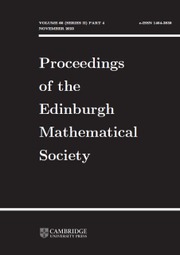No CrossRef data available.
Article contents
Linear metric spaces and analytic sets
Published online by Cambridge University Press: 20 January 2009
Abstract
Core share and HTML view are not available for this content. However, as you have access to this content, a full PDF is available via the ‘Save PDF’ action button.
A problem in descriptive set theory, in which the objects of interest are compact convex sets in linear metric spaces, primarily those having extreme points.
Information
- Type
- Research Article
- Information
- Copyright
- Copyright © Edinburgh Mathematical Society 1994
References
REFERENCES
1.Bourgain, J. and Rosenthal, H. P., Martingales valued in subspaces of L 1, Israel J. Math. 37 (1980), 54–75.Google Scholar
2.Haydon, R., A new proof that every Polish space is the extreme boundary of a simplex, Bull. London Math. Soc. 7 (1975), 97–100.Google Scholar
3.Jayne, J. E. and Rogers, C. A., The extremal structure of convex sets, J. Funct. Anal. 26 (1977), 251–288.Google Scholar
4.Kalton, N. J. and Peck, N. T., A re-examination of the Roberts example of a compact convex set without extreme points, Math. Ann. 253 (1980), 89–101.Google Scholar
5.Kalton, N. J., Peck, N. T. and Roberts, J. W., An F-space Sampler (London Math. Soc., Lecture Notes 89, 1984).Google Scholar
6.Kaufman, R., Co-analytic sets and extreme points, Bull. London Math. Soc. 19 (1987), 72–74.Google Scholar
8.Poulsen, E. T., A simplex with dense extreme points, Ann. Inst. Fourier (Grenoble) 11 (1961), 83–87.Google Scholar
9.Roberts, J. W., A compact convex set with no extreme points, Studia Math. 60 (1971), 255–266.Google Scholar
10.Talagrand, M., Un espace de Banach réticulé qui a presque la propriete de Radon–Nikodým, Studia Math. 76 (1983), 255–266.Google Scholar

